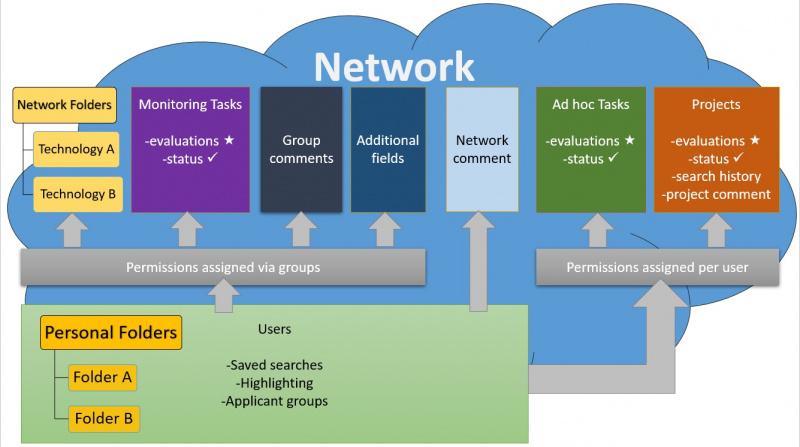EN:Network
In contrast to the stand alone license, the network is used for the collaboration of multiple users.
Different information (evaluations, comments, folder structures and many more) can be shared among the users.
This information can be managed by using rights for different user groups.
Additionally, certain processes can be automated in order to support processes in the company.
(automatic searches, monitoring tasks and observations)
It is also possible to create tasks manually in addition to the automated processes for other users.

Components
Network Folders
When creating folders any basis can be selected:
- Document
- Application
- strict family
- extended family
Depending on which basis was selected, individual documents of a family can be assigned to the folder or, for example, one representative per strict family.
For network folders specific rights for the specific user groups can be set up.
Monitoring Task
When creating monitoring tasks any basis can be selected.
(Document, application, strict or extended family)
Depending on the selected basis, individual documents or entire families are processed in the monitoring task.
The status always refers to the document but is displayed in relation to the selected basis.
If, for example, strict family is selected, the status is set for the displayed representative (document).
However, within the entire strict family the status is visible unless the basis of the result list is set to, for example, document. In this case the exact status of these documents is displayed.
The user must be assigned to the monitoring task in order to be able to open the monitoring task or process the contained patents.
The assignment is always carried out via a group.
It is possible to assign evaluation criteria to the monitoring task.
Users assigned to the monitoring task can use these evaluation criteria.
Reading / writing rights can be assigned for the evaluation criteria.
However, it is not possible for users to use evaluation criteria which are not assigned to the monitoring task, even if the users have the respective rights.
Group comment
Group comments can be assigned for individual documents or for the extended family.
For group comments specific rights for the specific user groups can be set up.
Additional fields
Additional fields are saved/displayed per document.
However, it is easily visible if a value for an additional field was previously assigned to a document of the same family.
For additional fields specific rights for the specific user groups can be set up.
Network comment
Network comments are saved/displayed based on the extended family.
All users in the same network are able to read, create or edit this comment.
Ad hoc-Task
When creating an Ad hoc task, any basis can be selected.
(Document, application, strict or extended family)
Depending on the selected basis, individual documents or entire families are processed in the Ad hoc task.
The status always refers to the document but is displayed in relation to the selected basis.
If, for example, strict family is selected, the status is set for the displayed representative (document).
However, within the entire strict family the status is visible unless the basis of the result list is set to, for example, document. In this case the exact status of these documents is displayed.
The user must be assigned to the Ad hoc task in order to be able to open the Ad hoc task or process the contained patents.
The assignment is always carried out via a group.
It is possible to assign evaluation criteria to the Ad hoc task.
Users assigned to the Ad hoc task can use these evaluation criteria.
This also applies if users don’t have rights to the respective evaluation criteria.
Project
When creating a project, any basis can be selected.
(Document, application, strict or extended family)
Depending on the selected basis, individual documents or entire families are processed in the project.
The status always refers to the document but is displayed in relation to the selected basis.
If, for example, strict family is selected, the status is set for the displayed representative (document).
However, within the entire strict family the status is visible unless the basis of the result list is set to, for example, document. In this case the exact status of these documents is displayed.
The user must be assigned to the project in order to be able to open the project or process the contained patents.
Each project contains a defined evaluation criteria “Basic”
Users assigned to the project can use the “Basic” evaluation.
Users can also see all evaluations in the evaluation history if they have the corresponding rights.
The users can additionally see all evaluations they created in the history.
(regardless of the rights being set up accordingly)
Each project contains a project comment.
The project comment is saved/displayed based on the extended family.
Users assigned to the project can use this project comment.
Personal Folders
When creating a folder, any basis can be selected.
(Document, application, strict or extended family)
Depending on the selected basis, individual documents of a family can be assigned to the folder or, for example, one representative per strict family.
Personal folders are only visible to the individual user.
Saved searches
Any user can create/save/open/edit searches.
Initially, these searches are only visible to the user.
However, users can share their searches with other users in the same network.
Highlighting
Any user can create/save/open/edit highlighting schemes.
Initially, these highlighting schemes are only visible to the user.
Applicant groups
Any user can create/save/open/edit applicant groups.
Initially, these applicant groups are only visible to the user.
However, users can share their applicant groups with other users in the same network.
